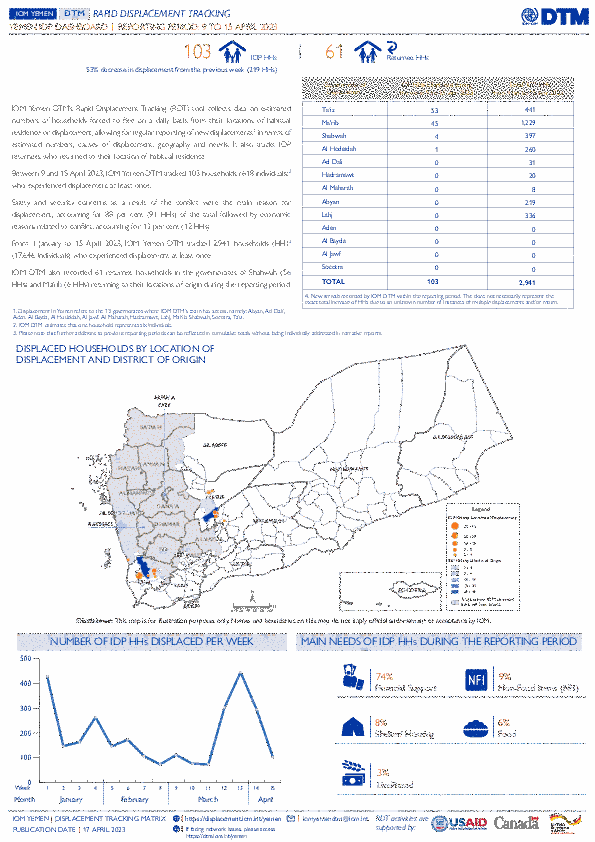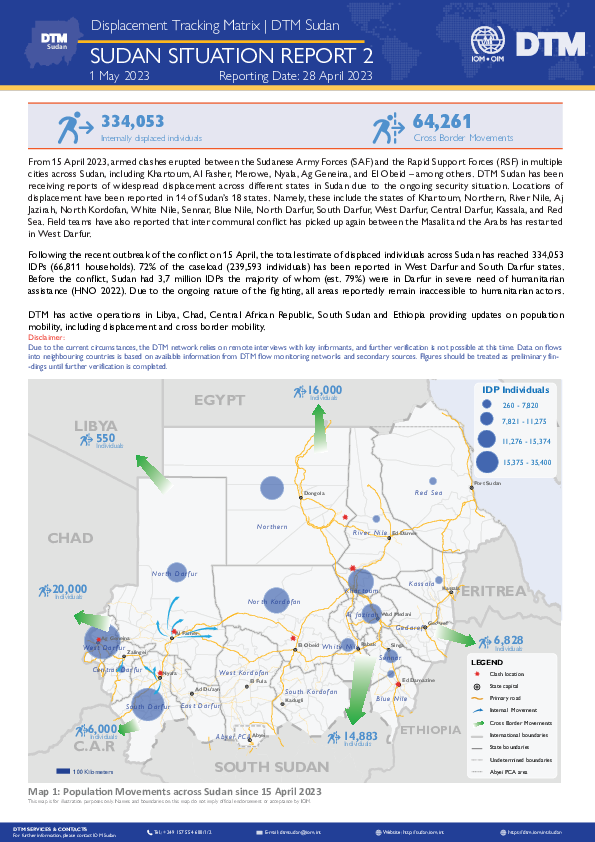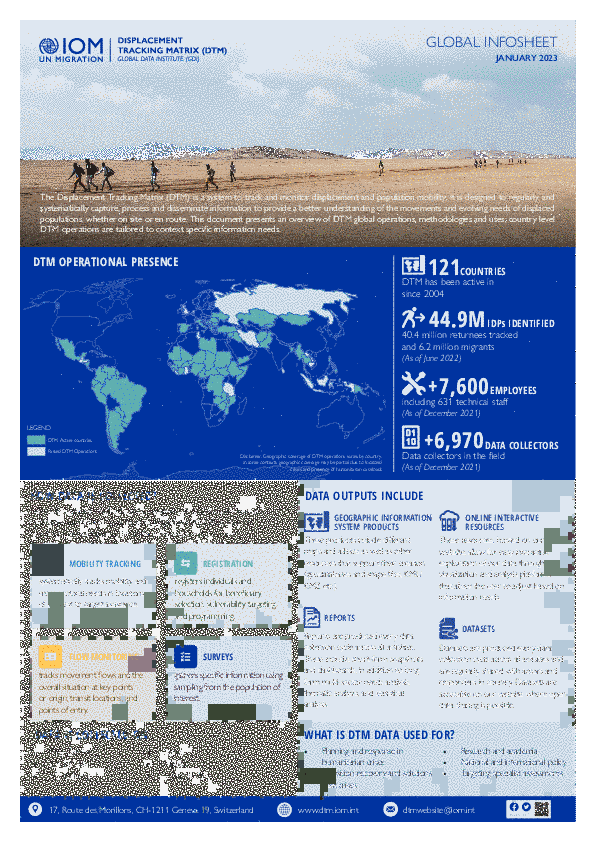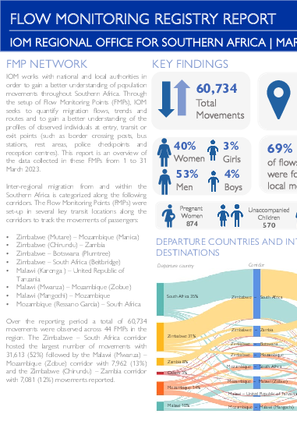-
Countries
-
Data and Analysis
-
Special Focus
-
Crisis Responses
Contact
DTM Burundi, DTMBurundi@iom.int
Location
Burundi
Activity
- Mobility Tracking
- Event Tracking
Period Covered
Apr 23 2023 -Apr 30 2023
Activated on an ad hoc basis, the DTM Emergency Tracking provides early field reports at the beginning of a complex crisis, allowing IOM to gather, consolidate and disseminate baseline information on displacement and return figures at the onset of a newly emerging crisis. The DTM Emergency Tracking relies heavily on information provided by RARTs or partners within the humanitarian community about an unfolding situation. The Emergency Tracking gathers data through IOM Burundi’s extended network of key informants, who provide basic information on the new displacement, be it of IDPs or returnees, or both, including numbers, location and shelter types. While IOM DTM strives to provide best estimates, the Emergency Tracking aims to be a quick monitoring tool with real-time data turnover ranging from 24 to 72 hours following its activation.
Population Groups
Survey Methodology
Unit of Analysis Or Observation
Type of Survey or Assessment
Keywords
Geographical Scope
Administrative boundaries with available data
The current dataset covers the following administrative boundaries

Contact
DTM Yemen, iomyemendtm@iom.int
Language
English
Location
Yemen
Period Covered
Apr 16 2023
Apr 29 2023
Activity
- Rapid Emergency Registration
- Mobility Tracking
IOM Yemen DTM’s Rapid Displacement Tracking (RDT) tool collects data on estimated numbers of households forced to flee on a daily basis from their locations of origin or displacement, allowing for regular reporting of new displacements in terms of estimated numbers, geography, and needs. It also tracks returnees who returned to their location of origin.
From 1 January to 29 April 2023, IOM Yemen DTM tracked 3,035 households (HH) (18,210 Individuals) who experienced displacement at least once.
Between 16 and 29 April 2023, IOM Yemen DTM tracked 75 households (450 individuals) displaced at least once. The majority of people moved into/within the following governorates and districts:
- Ma’rib (43 HHs) – Ma’rib City (25 HHs), Harib (17 HHs), Ma’rib (1 HH) districts. Most displacements in the governorate originated from Ma’rib and Al Hodeidah.
- Ta’iz (11 HHs) – Maqbanah (9 HHs), Al Mudhaffar (1 HH), Jabal Habashi (1 HH) districts. All displacements in the governorate were internal.
- Shabwah (10 HHs) – Markhah Al Olya (10 HHs) district. All displacements in the governorate were internal.
The majority of people moved from the following governorates and districts:
- Al Hodeidah (21 HHs) – Al Jarrahi (4 HHs), At Tuhayta (4 HHs), Az Zuhrah (3 HHs) districts.
- Ma’rib (19 HHs) – Harib (18 HHs), Raghwan (1 HH) districts.
- Ta’iz (14 HHs) – Maqbanah (13 HHs), Jabal Habashi (1 HH) districts.
Contact
DTM Yemen, iomyemendtm@iom.int
Location
Yemen
Activity
- Mobility Tracking
Period Covered
Apr 16 2023 -Apr 29 2023
From 1 January to 29 April 2023, IOM Yemen DTM tracked 3,035 households (HH) (18,210 Individuals) who experienced displacement at least once.
Between 16 and 29 April 2023, IOM Yemen DTM tracked 75 households (450 individuals) displaced at least once. The majority of people moved into/within the following governorates and districts:
- Ma’rib (43 HHs) – Ma’rib City (25 HHs), Harib (17 HHs), Ma’rib (1 HH) districts. Most displacements in the governorate originated from Ma’rib and Al Hodeidah.
- Ta’iz (11 HHs) – Maqbanah (9 HHs), Al Mudhaffar (1 HH), Jabal Habashi (1 HH) districts. All displacements in the governorate were internal.
- Shabwah (10 HHs) – Markhah Al Olya (10 HHs) district. All displacements in the governorate were internal.
- Al Hodeidah (21 HHs) – Al Jarrahi (4 HHs), At Tuhayta (4 HHs), Az Zuhrah (3 HHs) districts.
- Ma’rib (19 HHs) – Harib (18 HHs), Raghwan (1 HH) districts.
- Ta’iz (14 HHs) – Maqbanah (13 HHs), Jabal Habashi (1 HH) districts.
Population Groups
Survey Methodology
Unit of Analysis Or Observation
Type of Survey or Assessment
Keywords
Geographical Scope
Administrative boundaries with available data
The current dataset covers the following administrative boundaries

Contact
DTM Yemen, iomyemendtm@iom.int
Language
English
Location
Yemen
Period Covered
Apr 09 2023
Apr 15 2023
Activity
- Rapid Emergency Registration
- Mobility Tracking
IOM Yemen DTM’s Rapid Displacement Tracking (RDT) tool collects data on estimated numbers of households forced to flee on a daily basis from their locations of origin or displacement, allowing for regular reporting of new displacements in terms of estimated numbers, geography, and needs. It also tracks returnees who returned to their location of origin.
From 1 January to 15 April 2023, IOM Yemen DTM tracked 2,941 households (HH) (17,646 Individuals) who experienced displacement at least once.
Between 9 and 15 April 2023, IOM Yemen DTM tracked 103 households (618 individuals) displaced at least once. The majority of people moved into/within the following governorates and districts:
- Ta’iz (53 HHs) – Al Makha (33 HHs), Sabir Al Mawadim (15 HHs), Al Maafer (2 HHs) districts. Most displacements in the governorate originated from Ta’iz and Al Hodeidah.
- Ma’rib (45 HHs) – Harib (34 HHs), Ma’rib City (10 HHs), Ma’rib (1 HH) districts. Most displacements in the governorate originated from Ma’rib and Al Hodeidah.
- Shabwah (4 HHs) – Bayhan (4 HHs) district. All displacements in the governorate originated from Ma’rib.
The majority of people moved from the following governorates and districts:
- Ma’rib (41 HHs) – Harib (37 HHs), Al Jubah (4 HHs) districts.
- Ta’iz (40 HHs) – Maqbanah (38 HHs), Jabal Habashi (1 HH), Al Misrakh (1 HH) districts.
- Al Hodeidah (13 HHs) – Ad Durayhimi (7 HHs), Al Khukhah (2 HHs), Al Mina (1 HH) districts.
Contact
DTM Yemen, iomyemendtm@iom.int
Location
Yemen
Activity
- Mobility Tracking
- Event Tracking
Period Covered
Apr 09 2023 -Apr 15 2023
From 1 January to 15 April 2023, IOM Yemen DTM tracked 2,941 households (HH) (17,646 Individuals) who experienced displacement at least once.
Between 9 and 15 April 2023, IOM Yemen DTM tracked 103 households (618 individuals) displaced at least once. The majority of people moved into/within the following governorates and districts:
- Ta’iz (53 HHs) – Al Makha (33 HHs), Sabir Al Mawadim (15 HHs), Al Maafer (2 HHs) districts. Most displacements in the governorate originated from Ta’iz and Al Hodeidah.
- Ma’rib (45 HHs) – Harib (34 HHs), Ma’rib City (10 HHs), Ma’rib (1 HH) districts. Most displacements in the governorate originated from Ma’rib and Al Hodeidah.
- Shabwah (4 HHs) – Bayhan (4 HHs) district. All displacements in the governorate originated from Ma’rib.
- Ma’rib (41 HHs) – Harib (37 HHs), Al Jubah (4 HHs) districts.
- Ta’iz (40 HHs) – Maqbanah (38 HHs), Jabal Habashi (1 HH), Al Misrakh (1 HH) districts.
- Al Hodeidah (13 HHs) – Ad Durayhimi (7 HHs), Al Khukhah (2 HHs), Al Mina (1 HH) districts.
Population Groups
Survey Methodology
Unit of Analysis Or Observation
Type of Survey or Assessment
Keywords
Geographical Scope
Administrative boundaries with available data
The current dataset covers the following administrative boundaries

Contact
DTM Sudan; dtmsudan@iom.int
Language
English
Location
Sudan
Snapshot Date
Apr 28 2023
Activity
- Mobility Tracking
- Event Tracking
From 15 April 2023, armed clashes erupted between the Sudanese Army Forces (SAF) and the Rapid Support Forces (RSF) in multiple cities across Sudan, including Khartoum, Al Fasher, Merowe, Nyala, Ag Geneina, and El Obeid. DTM Sudan has been receiving reports of widespread displacement across different states in Sudan due to the ongoing security situation.
- Since 15 April 2023, DTM estimates that approximately 334,053 individuals (66,811 households) have been displaced.
- Notably, the current estimate for displacement during the last two weeks is larger than that recorded by DTM Sudan for all conflict-related displacement during 2022.
- Furthermore, an estimated 64,261 individuals have crossed into neighbouring countries.
Due to the ongoing nature of the fighting, all areas reportedly remain inaccessible to humanitarian actors. DTM estimates of displacement are based on preliminary reports from field teams and should be taken as estimations only. Additional reports of displacement are likely to emerge as the situation becomes clearer.
Locations of displacement have been reported in 14 of Sudan’s 18 states. Namely, these include the states of Khartoum, Northern, River Nile, Aj Jazirah, North Kordofan, White Nile, Sennar, Blue Nile, North Darfur, South Darfur, West Darfur, Central Darfur, Kassala, and Red Sea.
Disclaimer: Due to the current circumstances, the DTM network is relying on remote interviews with key informants and further verification is not possible at this time.
Apr 29 2023
Print
Type
Factsheet
Published date
Sat, 04/29/2023 - 13:24

Contact
DTM Pakistan, iomisbdtmremapteam@iom.int
Language
English
Location
Pakistan
Period Covered
Mar 26 2023
Apr 08 2023
Activity
- Flow Monitoring
Between 26 March and 08 April 2023, 1,591 undocumented Afghan nationals spontaneously returned to Afghanistan, including 1,054 through the Torkham border point and 537 through the Chaman border point. Border authorities facilitated the return of 337 individuals due to the lack of legal documentation to remain in Pakistan. Therefore, information about these individuals are not included in the count. Although IOM identified the period for the 20,517 undocumented Afghan returnees at two border crossings, this may not reflect the total number of undocumented Afghan returnees. Moreover, for this study, only the head of household or representative of the family were interviewed
IOM works with national and local authorities in order to gain a better understanding of population movements throughout Southern Africa. Through the setup of Flow Monitoring Points (FMPs), IOM seeks to quantify migration flows, trends and routes and to gain a better understanding of the profiles of observed individuals at entry, transit or exit points (such as border crossing posts, bus stations, rest areas, police checkpoints and reception centres). This report is an overview of the data collected in these FMPs from 1 to 31 March 2023.
Inter-regional migration from and within the Southern Africa is categorized along the following corridors. The Flow Monitoring Points (FMPs) were set-up in several key transit locations along the corridors to track the movements of passengers:
•Zimbabwe (Mutare) – Mozambique (Manica)
•Zimbabwe (Chirundu) – Zambia
•Zimbabwe – Botswana (Plumtree)
•Zimbabwe – South Africa (Beitbridge)
•Malawi (Karonga ) – United Republic of Tanzania
•Malawi (Mwanza) – Mozambique (Zobue)
•Malawi (Mangochi) – Mozambique
•Mozambique (Ressano Garcia) – South Africa
Over the reporting period a total of 60,734 movements were observed across 44 FMPs in the region. The Zimbabwe – South Africa corridor hosted the largest number of movements with 31,613 (52%) followed by the Malawi (Mwanza) – Mozambique (Zobue) corridor with 7,962 (13%) and the Zimbabwe (Chirundu) – Zambia corridor with 7,081 (12%) movements reported.

Contact
DTM Nigeria, iomnigeriadtm@iom.int
Language
English
Location
Nigeria
Period Covered
Apr 16 2023
Apr 24 2023
Activity
- Mobility Tracking
- Event Tracking
On April 16 and 24, several fire outbreaks were reported in Water Board Camp in Monguno Local Government Area (LGA), Borno state. The fire outbreak affected a total of 232 individuals and destroyed 45 makeshift shelters. The affected individuals included 141 children, 46 women and 45 men. The majority of those affected by the fire outbreak lost their personal items in the fire, including biometric cards and food ration cards. The fire outbreak was caused by the wind spreading cooking fires. One death was reported as a result of the fire outbreak. While the affected populations are working to rebuild their shelters, they presently live with their neighbours in the same camp.
Needs
Amongst the most urgent needs identified were food, shelter kits and non-food items (NFIs).
Response
At the time of reporting, no assistance has been rendered to the affected population.

